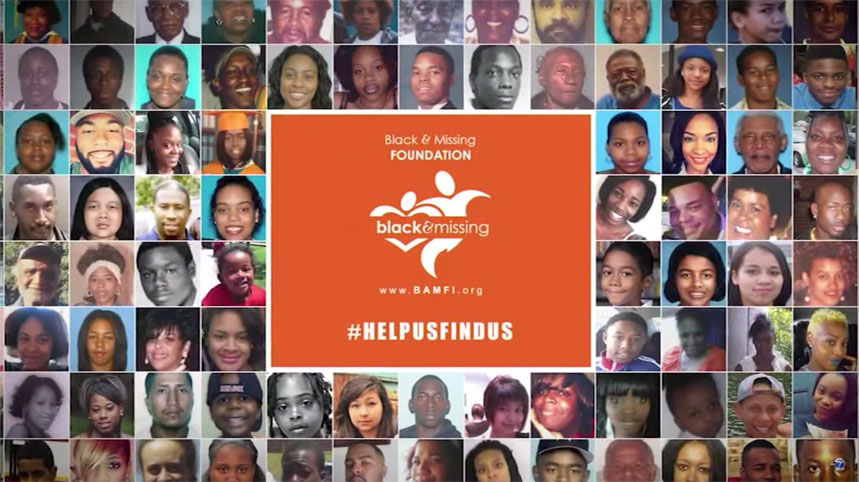Written By Kevin Fobbs and Susan Swift | Oct 1, 2021 | Coutresy of CommDigiNews
Does race play a part in who becomes America’s favorite missing child and becomes America’s canceled missing child? Does having blond hair and blue eyes, like Gabby Petito, determine who becomes America’s missing “daughter“? If you have brown skin and eyes, will you be kept in the nation’s media “canceled” color code shadow?
As the nation searched for Gabby Petito, who was searching for Jelani Day, a missing 25-year-old Black graduate student from Illinois State University? Who was searching for Nicole Wagon’s daughter Jocelyn murdered in 2019, and Jade in 2020? Both daughters were Indigenous. Wagon stressing to the Insider,
“I believe if my daughters even had half the coverage, maybe they would be solved,”? Does the media use Missing White Woman Syndrome as a news coverage Color Code?
Is Media Missing White Woman Syndrome real or an imaginary news idea?
“Missing white woman syndrome” or (“MWWS”) is a term coined by PBS anchor Gwen Ifill almost twenty years ago. It describes a possible racial bias phenomenon in mainstream news reporting. Many crime and media researchers believe there is provable racial bias in media. The result of this highly probable bias resulted in increased news coverage concerning missing white women.
Many mothers, fathers, sisters and brothers, and relatives of color have experienced MWWS far too often when loved ones have gone missing. Prof. Carol Lieber of Syracuse University has studied the MWWS media phenomenon and attests the bias is true.
Prof. Lieber stressed
“News media are extremely reliant on law enforcement in covering missing people. My research shows that police, not journalists, are the real gatekeepers in determining which missing people media pay attention to,” said Lieber. “Racial and misogynistic biases in police work are then reflected in what missing person cases are communicated to news media. Families are often shut out because news media rely on official sources.”
‘But do you not see us? Do you not see me? Do you not see my son?’
Are Americans of color simply invisible to the media because the media has a color code or narrative that is not color blind? Prof. Lieber believes that, despite detractors who naively claim the media is unbiased, societal bias does exist in news coverage. She blames “societal perception of beauty as well as law enforcement:
“The causes for MWWS are complex and reflective of certain dominant ideologies … and beauty ideals. It’s not just that Gabby Petito was white: She was young, thin, fit, blond. In other words, she fits societal definitions of beauty,”
Jelani Day went missing at age 24. For her mother, her child was invisible to national media.
The first-semester graduate student from Illinois State University was black and male. Thus, he was a perfect fit for the “canceled” color code profile. His mother pleaded with media, “But do you not see us? Do you not see me? Do you not see my son?” reported Opera News.
She publicly questioned the extreme difference in media coverage given to missing Gabby Petito. She expressed disappointment “that her son’s case did not receive enough resources as compared to another case being reported nationally.” Shortly after raising concerns, her son’s body was discovered in the Illinois River and identified.
Being indigenous also means that your precious children have a substantially higher rate of remaining invisible if missing or murdered.
Nicole Wagon, a Northern Arapaho woman from Wyoming’s Wind River Indian Reservation, believes media attention would have helped solve her daughters’ murders.
According to Insider,
“Wagon’s 30-year-old daughter, Jocelyn, and her boyfriend were found murdered in 2019. About a year later, her younger daughter, Jade, disappeared and was found dead weeks later.” Wagon still wants justice for her girls explaining to the Insider, “I believe if my daughters even had half the coverage [as Gabby Petito], maybe [their deaths] would be solved.”
Wagon appears closer to the truth than she may even know. What’s curious is the disparity in the Wyoming homicide rates reported between Indigenous people and white people. From 2010 to 2019, the murder rate for Indigenous people in Wyoming was 26.8%, eight times higher than the white homicide rate. “Over a similar time frame, 710 indigenous people, mostly girls, were reported missing in the state. The report also found only 30% of Indigenous homicide victims made the news, compared to 51% of white victims.” Was this a case of media oversight or an example of the media’s color code for news coverage?
Gabby Petito’s case sparks a call for attention to missing Indigenous women.
https://www.youtube.com/embed/7bUJHLibeuI
Race in Media Crime Coverage Analyzed for Possible Benefit of Whiteness
It is hard to dismiss the impact of a national media preference for reporting on a missing or murdered victim over an invisible, “canceled” victim.
Ask yourself one question. Do you remember national media and law enforcement searches for an American black, brown, or indigenous young man or woman? Probably every adult American can remember the endless media search for the murderer of six-year-old JonBenét Ramsey. The “beautiful” white girl was murdered in her Boulder, Colorado, home on December 26, 1996.
Many Americans have read about the national hysteria surrounding the March 1, 1932 kidnapping of Charles Augustus Lindbergh Jr. He was a 20-month-old son of aviators Charles Lindbergh and Anne Morrow Lindbergh. According to the FBI, he was stolen from his crib on the upper floor of the Lindbergh home.
Both cases are tragic. What is equally sad are the thousands of non-white victims, similar to Baby Lindbergh, Jon Benet, and Gabby. The glaring difference is that these victims remain invisible to the nation. Prof. Lieber says that “missing white woman syndrome,” or MWWS, is nothing new, and it is time to start delving deeper into the factors that cause it.
Media Blindness to its Coverage Color Code
In the 2017 Journal of Criminal Law & Criminology, Zach Sommers’ study presented an empirical analysis of race and gender disparities. In addition, the study outlined coverage of missing persons to see if data could provide a link to media Missing White Woman Syndrome.
According to a Scripps Howard News Service analysis, Sommers stated that child abduction reports from 2000 to 2004 led to 162 AP stories and 43 CNN reports dramatically overrepresented white children. He also stated
“[t]o establish a baseline racial composition for comparison, the researchers used data from the Department of Justice and the National Center for Missing and Exploited Children to estimate that between 53% and 54% of missing children from that time frame were white. In contrast, 67% of the AP reports and an even higher 76% of CNN stories focused on white children. As a result, there were disproportionately fewer stories highlighting black and Hispanic children.”
In addition, Sommers says
“Professors Seong-Jae Min and John C. Feaster found that missing black children were underrepresented in their sample of 161 nationally broadcast television news segments when compared to the racial composition of the overall missing children population. The finding was replicated in a later study. These three studies lay a foundation for establishing empirical evidence in support of MWWS.”
The New York Times reported that MWWS’s media coverage was literally in overdrive on nearly every news network and social media platform.
“There were also live briefings from Newsweek and The Independent, a British publication, and frequent segments on cable news channels. On Wednesday morning, the day after a coroner confirmed that the remains were Ms. Petito’s and determined her death a likely homicide, the case was the main story on the Fox News website. It was also a top online story at The Washington Post, USA Today, BuzzFeed, ABC News, CBS News, CNN, and NBC News.”
The increased intensity of the coverage has mirrored the interest of social media users who have discussed and debated the case on TikTok, Instagram and Twitter. The New York Times claims that news media can’t shake ‘Missing White Woman Syndrome.’
Furthermore, they report that media and social media users “poured over the videos and photos posted by Ms. Petito on YouTube and Instagram during her summertime cross-country trip.
As of Wednesday morning, the hashtag #gabbypetito had received more than 794 million views on TikTok.”
FBI and other Law Enforcement Crime Figures establish MWWS is Real
Documentation is pointing to an obvious fact. The national nightmare of tens of thousands of mothers and fathers and families of color with media invisible missing and murdered loved ones must end. Missing and murdered victims shoved into the media shadows must be replaced with colorblind coverage. The first step begins with mainstream media acknowledgment that MWWS is real.
Data shows that it does exist in hundreds of media organizations.
Many of the reasons for this canceled color code culture is how crime facts are manipulated.
Researcher Jada L. Moss agrees. She is the author of the 2019 study “The Forgotten Victims of Missing White Woman Syndrome: An Examination of Legal Measures That Contribute to the Lack of Search and Recovery of Missing Black Girls and Women in William & Mary College Journal of Race, Gender, and Social Justice.
In 2019, Moss’ study concluding
“missing whites are more likely to garner media attention than their non-white counterparts.” She emphasized, “[t]he prevalence of images of minorities as criminals in crime data is permeated throughout mainstream media. The statistics and empirical studies clearly show that minorities are over associated with crime and over-typified as criminal offenders. Studies have found the stark opposite outcome in the representation of minorities as victims.”
The 2013 Uniform Crime Report prepared by the Federal Bureau of Investigation states that
“Black Americans comprise only 28.3% of federal arrests. Similarly, a 2017 special report composed by the U.S. Department of Justice found that Black Americans comprise 22.7% of victims. When contrasted with the alarming rates at which Black Americans are portrayed as criminals in mainstream media, it becomes clear that racial disparity persists is driving perceptions and attitudes within the United States. It occurs on both individual and systemic levels.”
Gabby Petito case exposes racial disparities with missing persons:
Eyewitness News ABC7NY – September 24, 2021
# # #
The Sentencing Project’s 2014 report notes explicitly that news media, including television programs and printed media, consistently “over-represent racial minorities as crime suspects and whites as crime victims.” According to the National Center for Biotechnology Information, a research study came to a similar conclusion. The Race and Ethnic Representations and Ethnic representations of Lawbreakers and victims in Crime News found that television media outlets over-reported offending incidents of Black Americans compared to White Americans.
The researchers suggested that “the frequent reporting of black perpetrators may be a case of media reflecting dominant groups’ views through delegitimizing blacks by portraying them as criminal.”
Another university media researcher agrees that media directors, network producers, and networks must acknowledge that they are complicit in maintaining an MWWS keeping thousands of canceled families of color lost in a deliberate media blackout. Danielle Slakoff, an assistant professor at California State University, Sacramento, supports that narrative. A criminal justice and media researcher. Slakoff tells the New York Times:
“[r]esearch, including my own work, has shown that white missing women and girls do receive more initial coverage. They do receive more repeated coverage,” Slakoff added, “White women were typically depicted as good people, while women of color were often characterized as risk-takers or somehow complicit in their own disappearances.”
How to End National Canceled Media Color Code Culture and MWWS
The long national nightmare which has ignored far too many missing or murdered Americans canceled by the media’s color code of news coverage must end. The NAACP2021: National Association for the Advancement of Canceled People is committed to working with local, state, and national supporters and families victimized by the media’s canceled color code news coverage for generations.
In her study, Moss emphasizes the need for immediate remedies for families who need help, attention, and resources now. She highlighted the severe lack of missing person case remedies and efforts reserved solely for Black girls and women. She stressed the need for more coverage, investigation, and settlement of these targeted cases.
The Black & Missing Foundation, Inc is making a difference to help end the media-canceled color code coverage culture.
Black & Missing Foundation, Inc. (BMFI) is a non-profit organization began in 2008 by two Black women: Derrica Wilson is a veteran law enforcement official. Natalie Wilson is a public relations specialist.
The woman’s goal in creating the foundation is to increase attention to missing person cases involving African Americans.
Wilson recently telling AP News, “Public attention is vital in all missing-persons cases, especially in the first day or two after a disappearance.”
As the Black & Missing Foundation leader insists,
“[d]ispelling racism and stereotypes linking missing people with poverty or crime is key. Oftentimes, the families … don’t feel as though their lives are valued,” she added, “We need to change the narrative around our missing to show they are our sisters, brothers, grandparents. They are our neighbors. They are part of our community.”
*******************

Shut yo Mouth
If you want to know the truth about American Black History, get woke to what Cancel Culture is purposely hiding. Democrats are playing the race card to commit historical genocide. It’s all revealed in Shut Yo’ Mouth! How the Left Plays the Race Card to Silence Conservatives and How to Stop It.
It’s probably the most dangerous book liberals, BLM, and Antifa do not want you to read.
About the authors:
Kevin Fobbs began writing professionally in 1975. He has been published in the “New York Times” and has written for the “Detroit News,” “Michigan Chronicle,” “GOPUSA,” “Soul Source,” and “Writers Digest” magazines. In addition to the Ann Arbor and Cleveland “Examiner,” “Free Patriot,” “Conservatives4 Palin,” and “Positively Republican.” The former daily host of The Kevin Fobbs Show on conservative News Talk WDTK – 1400 AM in Detroit is also a published author. In addition, his Christian children’s book, “Is There a Lion in My Kitchen,” hit bookstores in 2014.
California PolitiChick Susan Swift Arnall is a lawyer, wife, and conservative mother of seven children. Since her impassioned call into Rush Limbaugh’s radio program in 2009, Susan has given political commentary on radio and blogs and was invited in 2010 by Andrew Breitbart to write for his young website Big Journalism. She has written over 60 published articles for Breitbart.









More Stories
‘We The Kids’ show 2nd PAB Award recognizes children as future patriots
Evil in the crotch of a tree, NPR warns against racist white privilege emojis
Emmett and Mamie Till to receive posthumous Congressional Gold Medal